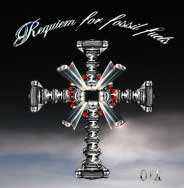
judson memorial church / new york (USA)
| videos on youtube.com . |
|
| Introitus | Kyrie |
| Dies Irae | Offertum |
| Sanctus | Benedictus |
| Agnus Dei | Communio |
Bruce Odland and Sam Auinger perform their composition Requiem for fossil fuels, playing an 8-channel “Orchestra of Cities” with
Hai-Ting Chinn - mezzo soprano, Martha Cluver - soprano, John Young - tenor, Joshua South - bass
There come times in life when the passing of great events requires formal acknowledgment to assist in their comprehension. As we face the passing of our fossil fuel dependent way of life, we hope to gain insight by examining the sounds of our culture through the lens of the Requiem Mass. - O+A
Requiem for fossil fuels is the culmination of twenty years of work by Bruce Odland and Sam Auinger, listening to and intervening in the urban soundscapes of cities around the world. In 2004, Odland and Auinger presented an early version of their Requiem for fossil fuels at the SophienKirche in Berlin as part of Inventionen Festival.
Materials for Requiem for fossil fuels come from O+A's “alphabet of sounds”. This collection of recordings is the result of an ongoing search for a “Hearing Perspective” of the sounds we make as a culture. Each section of Requiem for fossil fuels uses a location recording and its real-time flow as a cantus firmus. Over this cantus firmus, or baseline song, come soloistic voices of helicopters, jets, traffic, busses, horns, train wheels, footsteps of commuters, sirens: the found “Voices” of a fossil fueled culture organized as music. O+A have constructed this playable digital orchestra of extraordinary sonic voices extracted from cities around the world. Against and sometimes with this “Orchestra of Cities” are human voices of the singers and the text of the Requiem Mass.
Introitus
Cantus Firmus: a long time flow stereo “Tuning Tube” recording of Amsterdam Park, NYC,
8AM. October, 2003. This quiet park at the northern tip of Manhattan experiences early rush
hour at a safe distance. “Soloists”, i.e. truck horns, car doors, etc, make antiphonal answers.
(Recorded for Next Big Thing, WNYC radio, 2003.
kyrie
Cantus Firmus: long time flow stereo “Tuning Tube” recording of Amsterdam Avenue at 110th Street, an area of small shops and delicatessens, at 9:00 on a sunny morning in October, 2003. Against this real-time flow are balanced loops and cannons enhancing the overtone series of the original.
Dies Irae
Cantus Firmus: long time flow stereo recording of Grand Central Station at rush hour.
The everyday commuter experience, when listened to closely, contains frightening aural
imagery. This section contains the single time-stretched audio in this Requiem. The failing
brakes of an MTA train, stretched endlessly, fights against a barrage of acoustic phenomenon: commuter footsteps, underground train and subway fans and ventilators, cars and busses
presenting an ominous divertimento in cannons, fugues, and repetitions.
Offertorium
Cantus Firmus: “Blue Moon”, a Tuning installation by O+A at the World Financial Center”, May-August, 2004. This location, facing New York Harbor with its huge glass and steel courtyard, fragments and amplifies passing aircraft. Three tubes in the key of C, G, and D transform this chaos, along with the sounds of waves, water, and air.
Sanctus
Cantus Firmus: recordings of helicopter landing pad in lower Manhattan.
Benedictus
Cantus Firmus: recordings made by “miking-up” a car as a phonograph needle and scratching the surfaces of New York City’s crumbling bridges and roadways.
Agnus Dei
Cantus Firmus: “Box 3070”, sound installation by O+A, Rotterdam, 2001. A 4.5 meter tuning tube transforms the sonic environment by Erasmus Bridge and the Rotterdam Harbor. Countrapuntal answers come from recordings of the same piece in Alexanderplatz, Berlin. The tuning of the tube harmonizes the city’s signal tones into a musical environment.
Communio (Lux Aeterna)
Cantus Firmus: recordings of the Voest Steel Plant in Linz Austria, created for Peter Sellars’s “The Persians”. Sounds of a turboprop aircraft (Flugstunde,1994) are eventually buried by the sounds of making steel.